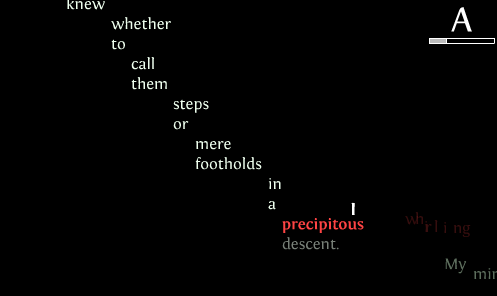This is the second in a series of posts about my interactive fiction system, Curveship.
In writing about Curveship in any detail, I’ll have to use terms such as action, event, and order, which sound ordinary but are used in a special way in the system. Furthermore, I’ll have to use terms such as focalization and narratee, which do not sound ordinary, but have a meaning within narratology (a.k.a. narrative theory) and are important to the way Curveship works. I’m going to define a few of these terms – some I’ll save for later. Rather than sort them alphabetically, I’ll group them by how they figure in the system.
Worlds of Curveship
Actual World. Following Marie-Laure Ryan’s terminology, I consider the main, simulated interactive fiction world to be the “IF actual world,” that is, what is “actual” from the standpoint of the player characters and other actors. I’ve bothered to give this a special name (rather than just calling it the world) because it isn’t the only ball in play in Curveship.
Concept. A concept, formerly called a “focalizer world,” is a particular actor’s theory of the actual world, based on knowledge (put into a fiction file to begin with) and perceptions (gained as the actor moves around and looks at things). Concepts are almost never complete, and they may be wrong. They allow the telling of actions and the description of items to be focalized, that is, based on what a particular actor knows and sees.
What Exists in the World
Item. Basically, any object that has a representation. I could have called them “objects,” but that term means something different in object-oriented programming, even though items do end up being represented as objects. I could have called them “existents,” the term Seymour Chatman and other narratologists use, but that caused gnashing of teeth among some of the people I consulted, including one researcher whose first language wasn’t English. Items must be in one of three categories.
Actor. An item that can take action on its own, due to either code that an IF author has written or a script the author has dropped in. Any item can react, but only an actor can initiate action. Actors are also the only category of item that have concepts.
Cosmos. The special actor that is the root of the item tree. Responsible for earthquakes, power outages, and any occurrence where the author doesn’t want to model the cause as its own actor. The cosmos can also change the plan for narrating, which allows for a connection between the simulated world and the way the telling of this world is done.
Room. A discrete location which has exits leading to other rooms. Rooms are all on the first level of the item tree, directly below cosmos.
Thing. Generally, an inert item. Any item that isn’t a room and doesn’t need to act or have a concept is a thing. Things can react when something is done to them or done in the same room, so that pressing a switch on a lamp can cause the lamp to react by increasing its glow.
Item Tree. A structure representing all of the items in the actual world (or in a concept) and the relationship between them. It is a graph with a designated node (cosmos), directed links from parent to child, and no loops – that is, no item is its own descendant. Hence, a tree.
Parent-Child Relationship. The relationship between an item and an item a level under it, and connected by a link, in the tree. When an actor walks into a room, he or she becomes the child of the room. If the room moves (perhaps it’s an elevator) the actor will move with it. If the lights in the room become brighter, the actor and everything else in the room will be better illuminated. An apple placed in a sack similarly becomes the child of the sack and, for instance, is stolen if the sack is stolen.
Link. The edges (as they are called in graph theory) of the item tree, each one connecting an item to another item and indicating a parent-child relationship. Links are labeled, with the label indicating more about the relationship. If a person is holding a sack with an apple inside and wearing a cloak, the sack and cloak are the children of the person and the apple is the child of the sack. Furthermore, the link between the sack and the person is labeled “of” (indicating a possession) and the link between the cloak and the person is “on” (indicating something being worn). The link between the apple and the sack is “in” (indicating containment). If you have ever tried to use Inform 6 to model a desk that you can put things on (on top of) and in (in a drawer), something which is not very straightforward to do, you will see an advantage to the way Curveship works.
What Happens in the World
Action. A specific but fairly high-level action taken by an actor. An intended command (such as “get lamp”) usually corresponds to a single action. It also usually doesn’t make sense for an action to partly succeed; it either works or doesn’t, although the first components of it may succeed and later ones may fail. The set of actions is open. Authors can easily make up new ones. Actions are what the system narrates, because they are meaningful and high-level.
Event. A lower-level component of action. There are only five, representing different things to be done in the world. Any action is made of one or more of these with appropriate arguments. The five primitive events are sense, impel, misc, modify, and configure. Only the last two change the state of the actual world, modify by changing a feature of an item and configure by changing the item tree. Events are good for simulating the world – unlocking and opening doors, moving actors from room to room, and so on. But because they are so low-level, they are not very good as a basis for narration. We usually do not want to hear that an actor exerted force on a switch, then turned the lamp on, and then increased the glow of the lamp. But it’s nice to be modeling this under the hood, because if the lamp’s battery is dead, an actor might be able to do the first two things but not the third. If the battery is then replaced, the lamp should glow brightly right away, since the switch is in the on position.
Files of Curveship
Fiction File. What others call the “story file” or “game.” It can be a game, of course. Essentially, though, it defines a fictional (and simulated) world.
Spin File. A very short file with a few parameters and perhaps a bit of code, all of which could be included in a fiction file. These parameters determine how the story is told at a fairly high level. Released games probably won’t use spin files, but sets of these may be used in research and teaching dealing with narrative, because they allow different methods of telling to be applied to the same fiction file (or a set of fiction files).
These are the building blocks of the simulation done in Curveship. I should note that Curveship is designed to mainly simulate the physical world, not emotional states or conversations between actors. And, of course, it models the way actions are represented and items are described based on concepts of that world – it narrates in different ways based on parameters and code provided by IF authors. I’ll discuss how it does that in a future post.







